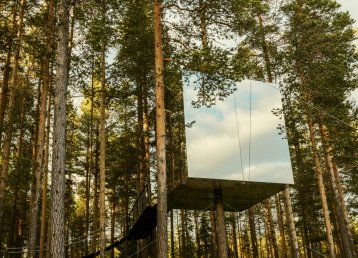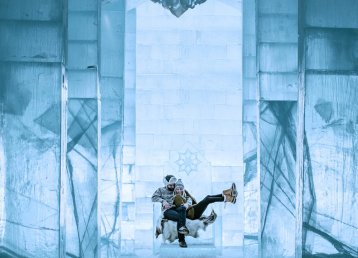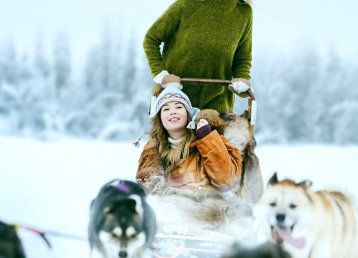On a beautiful day in early summer, beautiful as only early summer can be in the Torne Valley, I park my car by a red house in the village Vitsaniemi in the Torne Valley. Gunhild Stensmyr steps out of the red house – the Wennberg House – and greets me with her natural manner. The summer light is intense, but it is still early in the season, and everything feels fresh and new. Rosebay willowherb is still waiting to blossom while woodland geranium spreads its flowers along the roadside. The Torne River itself has left its spirited spring exuberance behind and is now a more normal size for a summer river. Finland can be seen on the other side of the water, and in every way, this is what makes this place even more exciting. One river, two countries, four languages and even more cultures. The Torne Valley is not like any other place on Earth.
— I’m standing here, looking out across the water, and it reminds me of the times I have stood in Louisiana in Denmark, looking out across Öresund. It’s so wonderfully inspiring.
— And on the other side of ‘the Sound’ lies Sweden.
— Yes, exactly. But here it’s Finland on the other side of the water. In any case, that was how the idea came about to create Konsthall Tornedalen – the Torne Valley Art Gallery. A vision of a northern Louisiana, where everyone has a place and a space, says Gunhild and continues:
— When I thought about what I wanted from an art gallery, I thought big, of course. MoMA or Liljevalchs, or Louisiana. At the same time, I’ve always seen things from my parents’ perspective. I’ve been thinking: “Would they have wanted to come here?” And if I’ve come to the conclusion that the answer is yes, I’ve kept going. But if it’s felt like they wouldn’t have liked the idea, that means it’s no good.
The thirst for life is an emergency exit
Gunhild Stensmyr comes from the neighbouring village Hedenäset, but she has spent a large part of her life in other places in Sweden. She studied in Lund and Umeå, then became the manager of Norrtälje art gallery, and then she had a house and her own art gallery in Skåne. So now, with the houses in the Torne Valley, she has come full circle.
In the 1950s, all of Sweden packed a suitcase and moved to the city. Since then, I suppose we have all been wondering why? Gunhild’s parents were no exception. They ended up in Skåne, where her father worked in a factory. He was one of those who often wondered why. One day, the very first day actually, as he was stood by the conveyor belt at the sausage factory in Malmö, he had had enough. He stopped tying sausages and just let the roll of sausage roll itself up on the floor while he left, through the emergency exit. Shortly after, the family moved back home – home to the Torne Valley. The parents were hard-working, and her father started his own business, but they also understood how important it was to have an education. Gunhild studied archaeology, ethnology and art history. She ended up as an art historian. She worked both at Umeå Bildmuseum, the university art museum, and Norrtälje art gallery before she started her own art gallery with her husband, in Skäret in Skåne.
— An art gallery also fills an educational purpose, educating people’s interest in art, not least children’s interest. It’s not only a point of sale, but it’s not a museum showing only what has been, either. An art gallery coexists with the present time in an amazing way.
Driven by homesickness
Over the years, her homesickness and the dream of a house in her childhood landscape grew stronger. Her brother told her a forest property in Vitsaniemi had come up for sale. The house was in terrible condition but had a well-preserved timber frame, and Gunhild wanted to bring the old wooden house to life. The first house, called Tolonen, was bought by Gunhild in 2009, and one year later, it was habitable for guests. She bought the Anundi property, at the other end of the village, almost at the same time, and after that, Wennberg – the house we are now sat outside, drinking coffee.
— All the houses are named after those who lived here. Wennberg was an official. His old clock and kitchen sofa were still in the kitchen when I bought the house. They got to stay, of course.
— Style is very much about daring to do what feels right. It’s not about something being nice or trendy. It’s about what I want myself to be.
— And by the way, I didn’t want to decorate these houses in any particular style. They just needed updating – they already had their style.
Personal connection
The Wennberg house is bright, light and clean. The house itself should take no space from the art; it should be the other way round. In every possible way, you understand how everything has its place. And everything has its story, from Børge Mogensen’s sofa suite and Mats Theselius’s classic armchair Bruno to Klara Kristalova’s painting in the entrance where Matthias van Arkel’s rubber cube is placed on the floor. And there is also a space for Margon Lindberg’s beautiful hares. Those hares of Margon’s show up here and there inside the house. Everything carries a kind of history – it has not been bought because someone is trendy. Instead, it means it is something that Gunhild has a personal connection to. The table in the kitchen of the Tolonen house was designed by Christian Halleröd and specially built by a local carpenter. Christian has been a friend of the family for a long time, so he has also designed details, sauna interiors, benches and wood storage for both the Tolonen house and the Anundi house. Wood is Christian’s favourite material to work with. He is best known for interiors in flagship stores worldwide, working for companies such as Byredo, Acne, Arigato and Arket. Halleröd’s signature is large spaces, clear-cut material choices and often unexpected combinations, sparse with smart details, and it can also be seen here in the Tolonen sauna. Practical, bright and recycled materials. When Gunhild bought the Anundi house, it had a lot of String shelves in the basement, left behind by the previous owner.
— Yes, that was a real bonus. It was so obvious for it to fill a space here. It’s nothing I’ve forced into the house just because String has become fashionable. It’s always been here.
A river runs through it
It is an exciting walk, simply put, joining Gunhild as she tells me who did what in the house, how everything ended up here, in this spot that gets so much love.
— Naturally, the Torne Valley Art Gallery has been my big vision throughout and the main idea. Yes, sometimes I think that’s the goal that keeps me alive, says Gunhild and continues: Yes, at least it’s what keeps my brain going.
We are stood out on the courtyard by the white Tolonen house, looking out over the mighty Torne River. On the other side lies Finland. Further upstream lies her home village Hedenäset and even further upstream is the Luppio mountain. If we listen carefully, we can hear the sound of the mighty Vuentokoski, lively summer rapids, a little downstream. Constantly this river is in motion, always this reminder of time and the present.
— But I haven’t exactly been idle. Waiting for the art gallery, I created a little hotel concept, she says with a laugh.
A disaster resurrected
If you are a traveller, or perhaps just interested in travel, you might be familiar with the Italian concept’ Albergo Diffuso’, a little carelessly translated as ‘the scattered hotel’. It began already in the 1980s in Italy. Abandoned mountain villages came to life when hotels were built using abandoned – and to some extent dilapidated – houses. There had to be a reception and a dining area, then the houses were renovated one by one and turned into exciting hotel rooms.
The idea behind the Albergo Diffuso started with a disaster following an earthquake in the Italian province Friuli. Giancarlo Dall’Ara, in those days a young professor of the hospitality industry, was commissioned to help in what way he could. He thought that instead of building a hotel, why not use the houses that were already there? Simply put: why stay at a hotel when you can live in the entire village? Today, the idea has spread to more than 140 locations in Italy but also to other parts of the world. Gunhild Stensmyr’s Arthotel in Risudden is that kind of wonderful place. The catastrophe was the unemployment that drove people to the cities, and the houses that were forgotten, or just botched renovations, are now resurrected.
An albergo for artists
An Albergo Diffuso can, in many ways, perhaps in every way, be seen as the most sustainable hotel project in the world, always following terms set by the very location and the people who live there. With all the love there is in preserving tradition, culture and history. Or, as the founder of the idea, professor Dall’Ara himself, has said: “This kind of hotel gives guests a chance to experience the most authentic, and perhaps elusive, experience the entire [place] – namely everyday life there.” An Albergo Diffuso is a hotel, but it was not built as such.
”— It’s the beauty of the place, the village’s beautiful location by the river, that creates my vision.”
– Gunhild Stensmyr
When Gunhild returned to her home region, she rediscovered the Torne Valley. The nature and the living environment here make it a worthy destination. From these thoughts, the concept of creating guest accommodation in existing houses emerged. With her background in the art world, it was, of course, unthinkable to have anything but art as the main idea when carrying out the project.
— It’s the beauty of the place, the village’s beautiful location by the river, that creates my vision. It was quite obvious to me from the beginning that the houses had to be preserved and restored to the condition they had when they were once built – simply bringing life back to them. Today the houses look like they once did, and they are named after their former owners, which is as much a part of the village’s cultural heritage as the houses.
— But the art and the art gallery will become another natural gathering place for villagers, Torne Valley inhabitants and travellers from all over the world.
The Arthotel, which is not a hotel per se, rather a home away from home, cares for its artists. The company name Arthotel actually stands for Artist Residency Tornedalen. Every year, sometimes several times per year, writers or artists stay here on scholarships to find and harness their creativity.
— My logotype: “Ah…” was actually created by the artist Fredrik Wretman, son of chef Tore Wretman. If you say it out loud, you will understand the feeling in my vision.
Summer swims and tarred wood
When the idea of an art gallery came about, Gunhild thought: “This is something the municipalities must have dreamed of for a long time; they’ll take to it immediately”. But that was not precisely the case. Gunhild says perhaps the timing was not right or that she – a returning female with a wild idea and quite a lot of energy inside of her – did not fit in. Perhaps cultural projects are not always seen as a solution to people moving in when people moving away is what dominates the agenda. These days the municipality’s attitude is entirely different, she makes sure to emphasise. Just like Gunhild herself, bringing ideas from the outside, most investors in the project are people who see the place from another point of view than the inside.
— But I’m a little surprised that there hasn’t been more interest from the businesses in the region. When Hjalmar Lundbohm created LKAB, he didn’t just dig a mining hole in the ground – he built a model city. It ought to be in everyone’s interest to create more attractions.
Finnish architect Anssi Lassila designed the Torne Valley Art Gallery. It started as a competition where four hand-picked architects from four countries were invited to participate. The four were ‘young and promising’ back then. These days they have all established themselves. Perhaps you could explain it as Anssi Lassila’s agency OOPEAA striving for an architecture for what is ‘in between’. That which is not one or the other, but that which unites. The countryside and the urban, for example, or as in the case of Torne Valley Art Gallery: culture and nature.
— We don’t have a park, like in Louisiana. But we have our nature and our beautiful location. Nature and culture always go together. Down there used to be the village bathing spot; we can recreate that. First, you take a swim, then make some coffee on one of the fireplaces. After that, with hair smelling like a summer swim, and clothes like tarred wood, you take a tour around the art gallery.
— As a performance?
— Yes, exactly. Like being your own ‘performance artist’.
Art
“What is art?” I ask the question on the morning I am leaving because I still fumble with the concept. Gunhild laughs and asks me if I am unfamiliar with the saying: “If you can’t drink it, eat it or sleep with it – it’s art”. I must admit I have not come across this particular wisdom, but I understand that it is a good explanation. Because outside of man’s natural wish to stay alive and reproduce, there are other driving forces, abilities and dreams. We create an expression to give others the impression of us having actually been here, whether it be a magnificent mural or a simple handprint in a cave. See me; I was here too.
But art and culture are not just a cry or expression for more privileged people to experience. Art and culture are major reasons for travel these days. Taking Louisiana as an example, it is one of Denmark’s leading destinations, included on the list as one of ‘1,000 places to see in life before you die’ by Patricia Schultz. It is one of the most visited museums in the world, even though it is located in the countryside, in a small village – not at all in the middle of a capital city. When Knud W. Jensen opened Louisiana in 1958, they were hoping for a few thousand visitors per year, but during the first year alone, three times as many showed up.
— But you must remember that the art gallery has nothing to do with me, not as a person. Even so, it’s my personal vision that I want to convey. I know it sounds pretentious to say that you want to ‘give something back to a place’. This place and this valley are so much bigger than that. Still, it’s impossible not to think that Torne Valley Art Gallery could give so much back and have so much to add to this particular place.
— Always with mum and dad at the back of your mind?
— Yes, that’s exactly it! If the Torne Valley inhabitant isn’t proud of this – then who would be?
Learn more about Arthotel Tornedalen at arthoteltornedalen.se.
































